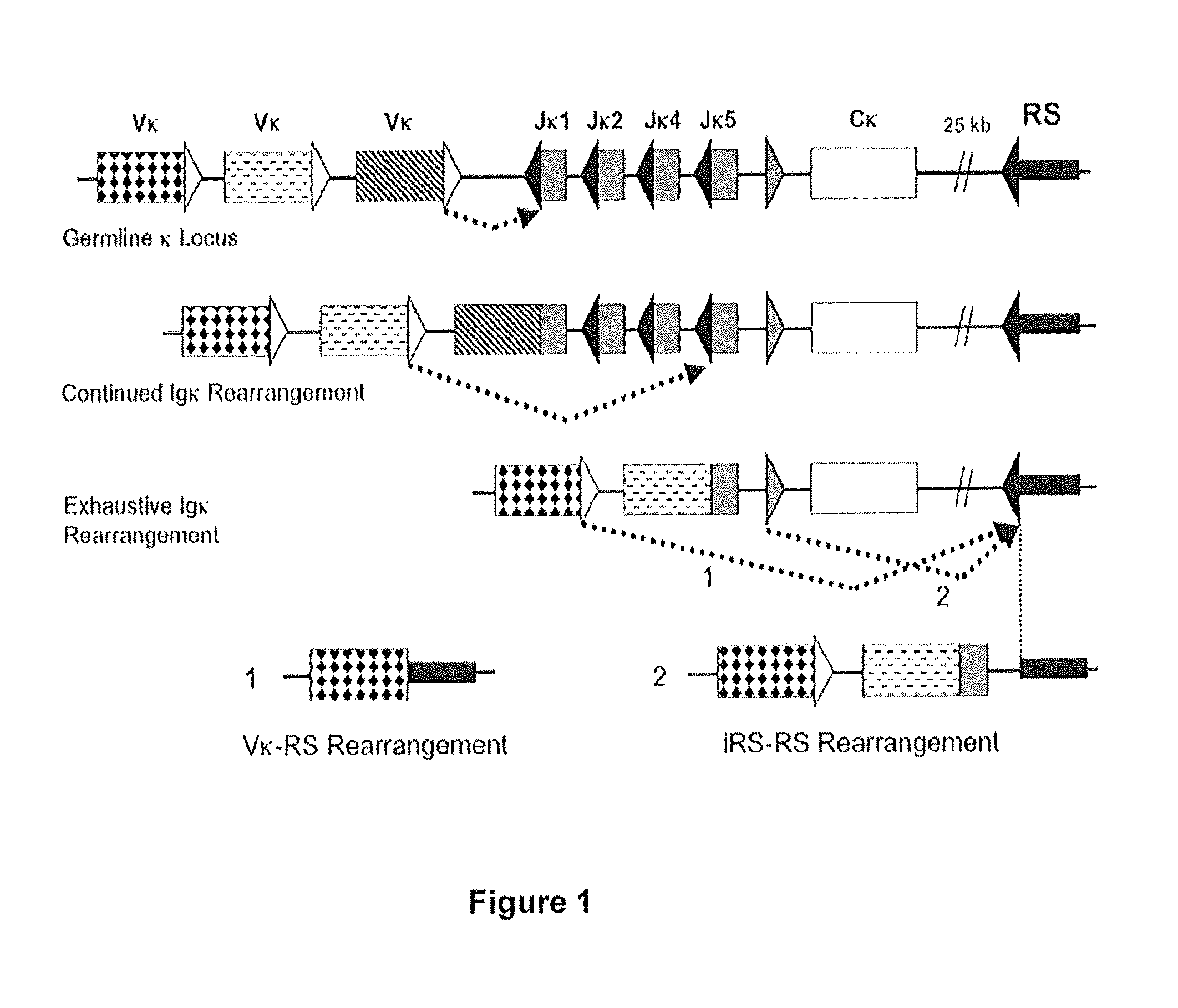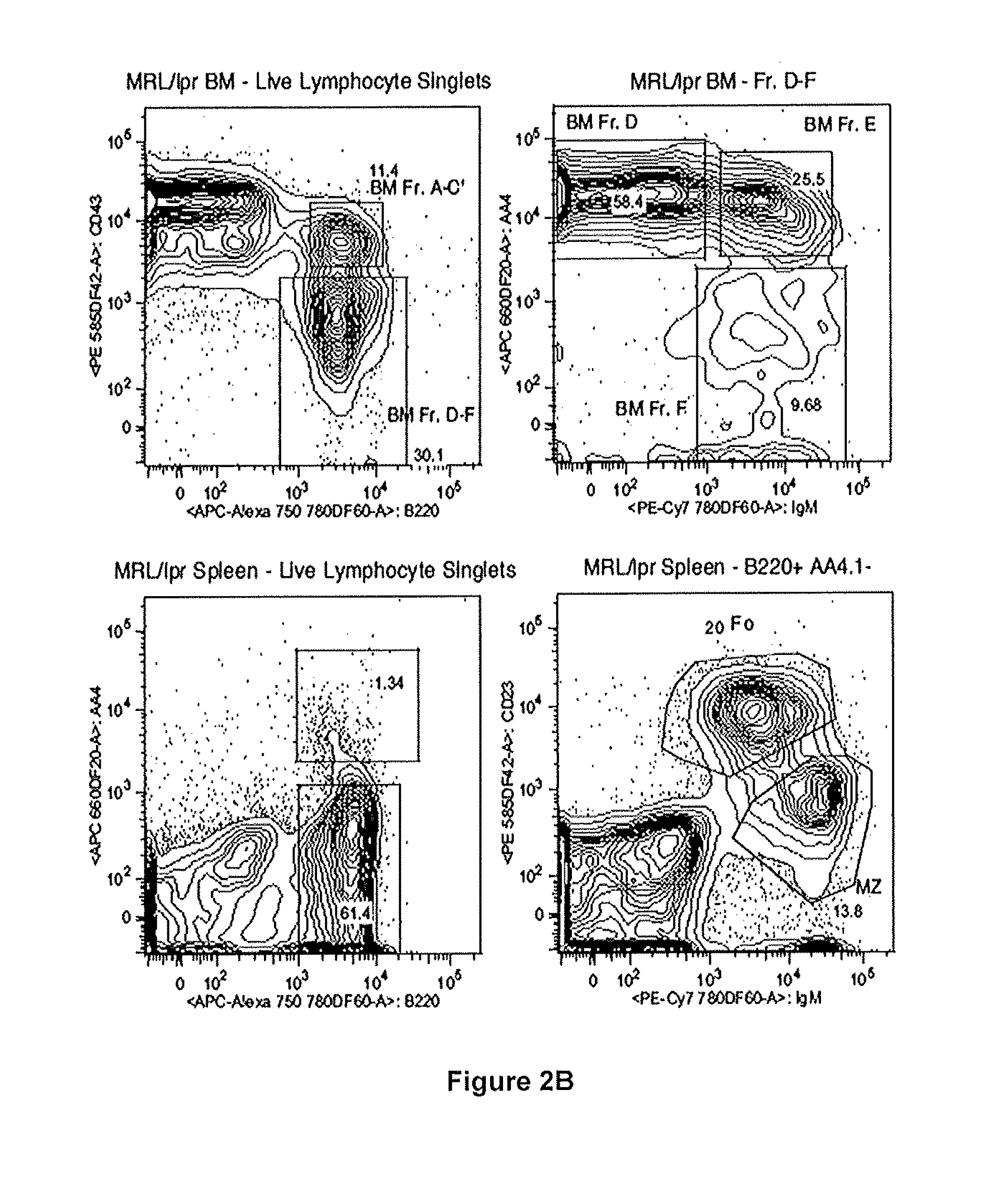Recombination Sequence (RS) Rearrangement Frequency as a Measure of Central B Cell Tolerance
a technology of recombination sequence and frequency, which is applied in the field of recombination sequence (, can solve the problems and achieves the effect of reducing the level of rs rearrangement and increasing the risk of future autoimmunity
- Summary
- Abstract
- Description
- Claims
- Application Information
AI Technical Summary
Benefits of technology
Problems solved by technology
Method used
Image
Examples
example 1
Recombination Sequence (RS) Rearrangement Occurs Late During Light Chain Gene Rearrangement
[0194]The results presented herein demonstrate that recombination sequence (RS) rearrangement occurs late during light chain gene rearrangement. This is consistent with its role in light chain receptor editing. This result is further supported by higher levels of RS rearrangement in λ B cells than in κ expressing B cells and therefore supports the model of ordered progression of light chain rearrangements starting with κ, proceeding to RS and λ rearrangements.
[0195]The following examples describe a quantitative assay for RS rearrangement that can be used to estimate levels of antibody light chain receptor editing in various B cell populations. RS rearrangement is a recombination of a non-coding gene segment in the κ antibody light chain locus. It was observed that RS rearrangement levels are highest in the most highly edited B cells and inappropriately low in autoimmune mouse models of systemi...
example 2
RS Rearrangement Levels Differ Between Autoreactive and Non-Autoreactive B Cells
[0205]The results presented herein demonstrate that RS rearrangement frequencies are higher in B cells from self-tolerant mice that express an autoreactive heavy chain (56R). This finding suggests that light chain rearrangement is increased in autoreactive B cells.
[0206]The experiments were designed to determine how or if RS rearrangement frequency is linked to autoreactivity. It is believed that editing is driven either by the potential of the antibody heavy light chain pair to form autoantibodies (active model), or it occurs without regard for receptor specificity (passive model). To distinguish between active and passive editing, RS rearrangement frequencies were analyzed in the 56R mouse model, where the B cell repertoire has been characterized extensively (Li et al., 2001, Immunity 15(6):947-957; Sekiguchi et al., 2006, J Immunol 176(11):6879-6887; Liu et al., 2007, J Immunol 179(2):1340-1352). This...
example 3
Mouse Strains Prone to Autoimmunity Display Lower Levels of RS Rearrangement
[0207]The results presented herein demonstrate that RS rearrangement frequencies are decreased in two different mouse models of autoimmunity, MRL / lpr and NOD. The low levels of RS rearrangement are also present in the control strains MRL / MpJ and NOR, which were not observed to developed autoimmunity. These results suggest that RS rearrangement frequency may predict disease development rather than arising as a consequence of disease.
[0208]The experiments discussed elsewhere herein establish the developmental timing of RS rearrangement and demonstrate a positive correlation between RS rearrangement frequency and an autoreactive antibody heavy chain in inbred mice. To determine if RS rearrangement is altered in the context of autoimmunity, RS rearrangement frequency was measured in two different mouse models of autoimmune disease, MRL / lpr mice as a model of SLE and non-obese diabetic mice (NOD) mice as a model ...
PUM
| Property | Measurement | Unit |
|---|---|---|
| Tm | aaaaa | aaaaa |
| Tm | aaaaa | aaaaa |
| Tm | aaaaa | aaaaa |
Abstract
Description
Claims
Application Information
 Login to View More
Login to View More - R&D
- Intellectual Property
- Life Sciences
- Materials
- Tech Scout
- Unparalleled Data Quality
- Higher Quality Content
- 60% Fewer Hallucinations
Browse by: Latest US Patents, China's latest patents, Technical Efficacy Thesaurus, Application Domain, Technology Topic, Popular Technical Reports.
© 2025 PatSnap. All rights reserved.Legal|Privacy policy|Modern Slavery Act Transparency Statement|Sitemap|About US| Contact US: help@patsnap.com



